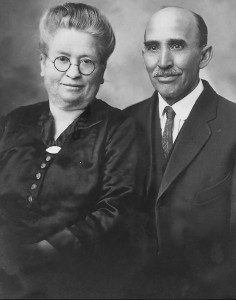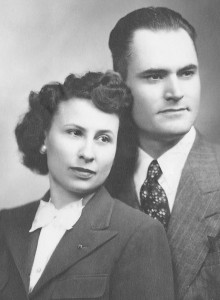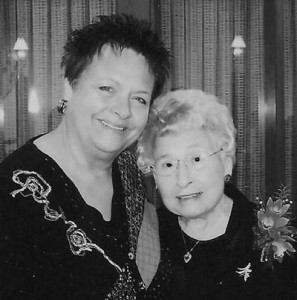Two Schrock Women--108 and Counting
by Donna Schrock Birkey
Originally published in the Summer 2012 issue (Vol. XXXIX • No. 2)
Illinois Mennonite Heritage Quarterly (http://www.imhgs.org) – (Used with permission of original publisher)
Two Schrock women, Estelle Elizabeth Schrock Lewis and Lydia Mae Schrock, both turned 108 in 2012. Third cousins, but they have never met. However, they have
A common childhood
Both grew up on farms and experienced the rigors of early farm life in America.
A common ancestry
Both are great-great granddaughters of Joseph and Marie Neyhousser Schrag.
Lydia Mae is great-granddaughter of Johannes and Catherine Salzman Schrock, granddaughter of Joseph and Magdalena Guingrich Schrock, daughter of Jonathan and Naomi Gerber Schrock.
Estelle Elizabeth is great-granddaughter of André and Anna Oyer Schrock, granddaughter of Joseph and Mary Risser Schrock, daughter of Joseph and Fannie Ehresman Schrock.
A common religious heritage
Both women descend from a long line of Amish Mennonites who emigrated from France to America.
Lydia Mae’s immediate family left the Illinois Amish Mennonite community to become members of the Apostolic Christian Church, and she remains in that tradition.
Estelle Elizabeth’s grandparents moved to California about 1876. Her parents left Illinois for Kansas during the 1890s and the family eventually became members of the Nazarene denomination where she continues to worship today.
Estelle Elizabeth Schrock
Estelle Schrock was born October 21, 1904, on a farm seven miles southwest of Sterling, Kansas, fifth and last child of Joseph Schrock and Fannie Ehresman. Joseph was a farmer, as was his father Joseph.

Joseph & Fannie Ehresman Schrock, a few years before Fannie’s death in 1934.
Photo Courtesy Joy Ehresman Rachoy.
Joseph and Fannie had three other children of their own: Mary, Elsie, and Frank. They also raised Emanuel Ehresman, a half brother to Fannie, from the time his mother died when he was 11 months old to adulthood.

Joseph Schrock Family, January 1918. L to R: Elsie (Pickens, Akers), Frank Schrock, Mary Schrock & husband Roy Ball, Emanuel & Martha (Rich) Ehresman, Estelle Schrock (Lewis). Front Row: Grandma Fannie holding LaVerne Ehresman, Merle Ehresman, Grandpa Joseph holding Kenneth Ball.
Photo courtesy Joy Ehresman Rachoy
The family owned the farm near Sterling, where they lived and produced primarily wheat and alfalfa. The majority of their food came from a large garden and the livestock they raised. “I remember having to get up at 5 o’clock in the morning to milk the cows,” Estelle said. “I did the normal chores that a child had to do: carried wood in for the stove, pulled weeds in the garden, set and cleared the table, helped my mother in the kitchen, tended the chickens, and learned to cook. I had older sisters, so I didn’t really learn to sew as much.”
On occasion, the family hitched up their carriage to the two horses and headed the seven miles to Sterling on a Saturday night. On Sundays they would gather in the pews of either the Missionary Bible Church or the Mennonite Church, both about three miles from the farmstead. “After church, we would usually have company over for dinner or we would go to someone’s house, “ Estelle recalled. “ I liked playing with my friends.”
Estelle was a rather shy child but enjoyed playing “house” and “school” with her sister. Even though Estelle was the younger by a year and a half, the two took turns playing pupil and teacher. She played outdoors a lot and made a lot of mud pies.
Estelle’s “real” school days were spent at Union 5 School—a small country school with four classrooms for students through grade 8. The Schrock children were transported about three miles to school by a horse and a hack (Estelle described it as a horse-drawn school bus). By the time Estelle was 9 or 10, the family traded their team and carriage for a new Model T Ford. “That was a big deal,” she remembered.
Later, Estelle and her sister, Elsie, attended high school at Brezee College in Hutchinson. It was somewhat unusual for her parents to send two daughters to live as boarders with a Hutchinson family to attend classes, but they wanted the girls to attend a church school.
For Estelle, World War I hit close to home. Her brother Frank served in the Army, based at Fort Riley where the family drove to see him. “As a child, you don’t pay as much attention to how things like war affect you, but I do remember one thing that was rationed was sugar.”
After the war and Estelle’s graduation from high school in 1923, the Schrocks traveled from Kansas to Los Angeles in their Model T Ford to visit friends and family (including her grandparents, Joseph and Mary Schrock). Along the way, they slept in tents at campgrounds, cooking their meals over a campfire. It was a trip full of discoveries and the first time Estelle and her sister Elsie had ever seen the mountains or the ocean. It also launched her career.
Estelle’s parents’ friend arranged a job for her, so she stayed behind in California when the family returned to Kansas. She worked in the office of an architect for 2 ½ years, then when her father got sick, took the train back to Hutchinson where she continued work as a stenographer and bookkeeper at the Farmers Cooperative Commission Co., based at the Wiley building.
As a young single woman, Estelle felt fortunate just to have a job when the stock market crashed in 1929. “I did have to take a pay cut,” Estelle said. “I had been making about $100 a month, and then I was reduced to about $12 a week. But it was a job.
In the early 1930s Estelle was hired on at United Power and Light. A bookkeeper for the company seemed to take a special interest in the electric meters–or perhaps the secretary in the room where the meters were stored, Estelle admits. Estelle married that bookkeeper, Philip Lewis, in a simple ceremony at her parents’ home in Hutchinson in 1935. They would celebrate their 49th wedding anniversary before Phil died in 1986. He had retired from his job as Vice President of Borten, Inc. after more than 30 years. They spent those 49 years together in the first and only home they had built at 2016 N. Monroe Street, Hutchison, Kansas.

Estelle & her husband Phil Lewis.
Photo courtesy Joy Ehresman Rachoy
While the decade of the 1930s brought a great change in Estelle’s personal life, it also brought landmark changes in U. S. culture.
“I’d say some of the biggest advances were getting electricity,” said Estelle. Since they lived in Hutchinson, they had electricity much sooner than the neighbors Estelle grew up with on the Sterling farm. Electricity changed how people lived their lives. One of the biggest changes was in refrigeration,” Estelle said.
“When we lived on the farm, we would get ice, 300 pounds at a time,” Estelle said. “We would have to put it in the icebox to keep the food cold. Prior to refrigerators becoming commonplace in kitchens, much of the produce and meat produced on the farm was canned and stored at room temperature,” said Estelle. It was during this decade that Estelle took her first plane ride, traveling to Europe on vacation with her husband.
Estelle remembers hearing the news about the bombing at Pearl Harbor after attending church that Sunday in 1945. However, World War II didn’t impact Estelle as personally as the First World War, since she didn’t have family members involved. Like many women of the era, Estelle did her part for the troops by knitting sweaters. She had tried quilting at one point in her life but admits that baking was her best domestic task.
Estelle also remembers watching the moon landing on television three decades later. “ I remember looking up at the moon, then watching the astronauts and thinking, ‘Oh mercy me! This is amazing.’” All throughout her lifetime, Estelle was amazed at the advances in transportation. “I went from the horse and buggy to the automobile to flying,” she said.
Even though computers and technology grew by leaps and bounds in the following years, Estelle never joined the ranks of computer users. “It was beyond me,” Estelle said. However, she eventually did join the millions of Americans with cell phones. “It’s pretty amazing,” Estelle said. “When I was growing up, our phone was a big box attached to the wall. We were on a party line, and when it rang three times, that was our phone call and not the neighbors. And now we have cell phones that keep getting smaller.”

Joy Ehresman Rachoy with Estelle on her 105th birthday.
Photo courtesy Joy Ehresman Rachoy
After her husband’s death, Estelle remained in the family home until 2007, when she moved to Wesley Towers. She remained active in their church, First Church of the Nazarene in Hutchinson, where she served as financial secretary for a number of years and was secretary of the adult Sunday school department “for practically all my life.” There is presently a gymnasium on the church campus named “Lewis Center” for Phil and Estelle. It was also at this church that Estelle was able to sing her favorite song, “Amazing Grace.”
She attributes part of her longevity to walking. For years, she walked two miles a day, rain or shine. She stopped walking the two miles
when she was 102 years old. Estelle said, “It was a cold winter day and I went to get dressed for my walk. I really didn’t feel like it and said to myself, ‘You are 102 years old and I think you can do what you want,’” she said with a laugh. That was the last of her walks.
“I’ve lived a good life,” she said, “we were underprivileged, but we didn’t know it. I’ve been fortunate to be as healthy as I’ve been. Some parts of old age aren’t so good, but there are a lot of people worse off than I am.”
Lydia Mae Schrock
Quite unheard of in the Jonathan Schrock household, big brothers Noah and Jesse were instructed to “go fishing” on Sunday morning May 1, 1904. Big sisters Nettie, Nima, and Ada were to find something exciting to occupy their time for a few hours. When all five children returned to the house later, how delighted they were to find a brand new baby sister snuggled in her little cradle!

Lydia Mae at the 2010 Schrock Reunion in Metamora, IL.
Photo: Donna Schrock Birkey
During their time away, Lydia Mae was born on that Sunday into the family of Jonathan and Naomi Gerber Schrock. She would later be known to a host of Schrock family members as “Aunt Mae.” The family home was in Congerville, Illinois (originally named Schrock), and all of the siblings attended school in that village. Mae loved arithmetic and spelling. During a spelling bee, Mae and her brother Joe were the last two survivors. After a few difficult words, Mae emerged the winner!
Mae was a happy, carefree child, growing up with brothers who played tricks on her. Once she was told to catch a sheep and milk it and she would get ice cream. Off Mae ran to find a black sheep, for surely it would give chocolate ice cream!
Quite the young entrepreneur, Mae bought a setting of duck eggs from a friend. As a result of her expert nurturing they all hatched. In the fall Mae took the ducks to the grocery store and sold them to the grocer for the huge sum of $8.88, which was wisely spent on books. That profitable project probably sparked another in which Mae and her sister Ada gathered little chicks that had hatched in the fields and raised them until large enough to sell. Then there was Grandmother Schrock who paid Mae 25 cents for keeping her wood box filled with wood that she burned in her small stove. Mae had an eye for profit!
But not every new attempt turned out successfully, such as the cake Mae baked for company but didn’t realize she had added Watkins cough medicine instead of vanilla. And yet another time she omitted the baking soda, so the cake was flop—literally.
In May of 1919 Mae, Nettie, and Nima were baptized in the Mackinaw River. The service was in German. The Apostolic Christian church elder wore hip boots and walked into the river with the sisters.
Her earlier business success no doubt help Mae land her first employment. She took the job of washing bottles for the newly established Schrock Dairy begun by her brothers Joe and Alvin. Mae earned every penny of her 10 cents an hour salary, since the bottlebrush was run by electricity! But in the end the dairy business dwindled and the brothers started a new business, Schrock Hybrid Corn Company. A CPA was hired to help start the accounting department by teaching Mae everything he knew. Since arithmetic had been Mae’s favorite school subject, the job grew into one that Mae loved.
The annual two-week vacation perk attached to the position provided Mae with an opportunity to feed her love of adventure and took her to far corners of the country.
Her first “real” trip was to Florida by way of Mississippi with four relatives, to visit other relatives. All along the way they stayed in dingy cabins, and once in a hotel that was overrun with gigantic cockroaches. Mae later set that entire trip to poetry, 21 pages in length. Later trips were to Michigan, Colorado, and one to Maine with an Audubon Society tour.

Lydia Mae tells one of her many stories at her home in 2011.
Photo, Donna Schrock Birkey
In 1948 Mae drove west with her sister Ada and ended up in California. They built a house and Mae found an office job. After a trip to Hawaii with a cousin, and then to Canada, Mae returned to Congerville and her job at Schrock Hybrid. But that didn’t satisfy Mae’s wanderlust: she travel to Israel and Egypt, spent 23 winters in Florida driving down and back until her 90th birthday.
Mae’s health continues to be good even while turning 108 on May 1, 2012. Her longevity could be a result of laughter. Her family relates that Mae laughed through childhood and on into adulthood, and the laughing continues each day at the lunch table at Apostolic Christian Restmor in Morton, Illinois. Her life has been filled with fun and adventure, while always honoring God and acknowledging his goodness.
“Aunt Mae”, although never married, is an inspiration to her family of 21 nieces and nephews and to anyone who has ever had the privilege to know her.
Author’s Note:
In October of 2011, I received e-mail from Joy Ehresman Rachoy in response to my article about Andrew and Anna Schrock in the summer 2011 issue of Illinois Mennonite Heritage Quarterly. In part her e-mail read:
“I have roots to Fannie Ehresman who married Joseph Schrock (#13 page 35 of the issue). My Grandfather, Emanuel Ehresman (1889-1959), was Fannie’s half-brother. He was 11 months old when his mother died (Mary Oyer 1859-1890). Fannie and Joseph had been married for only four months when they took Emanuel to raise him. They had four children of their own: Mary Ella, Frank Ezra, Elsie Mae and Estelle Elizabeth. My great-aunt Estelle is still living in Hutchinson, Kansas and will be 107 years old in 5 days (Oct 21, 2011). She still has clear thinking and can answer questions for me about my heritage. However, you have to talk pretty loud and she can’t see far away. I have had the privilege of going to help her celebrate her last 6 birthdays. What a thrill for me.
“I do so appreciate all of the Quarterlies I receive, even if I am not related to anyone mentioned that month.
“My husband and I were able to visit the Mennonite Heritage Center in Illinois in 2008 and were able to give large chalk drawings of Christian Ehresman (1832-1893) and Magdalena Wagler (1831-1870) Fannie’s parents, to the museum. I truly enjoyed my time there.”
Of course, the mention of Estelle still being quite alive at age 107 caught my attention—another Schrock woman lives to be 107! Estelle, living in Kansas, I calculated, would be a third cousin to Lydia Mae Schrock living in Illinois.
Eventually, I received photos from Joy Ehresman Rachoy and interviews from Dick and Linda Ehresman. My thanks to them for their help in telling the story of these two noteworthy women.
Bibliography
The Days of Yesteryear in Woodford County, Illinois, by Mae Schrock, 2001.
This is Your Life, Aunt Mae Schrock, prepared by family members and read at the occasion of Mae Schrock’s 100th birthday, 2004.
Interviews with Estelle Schrock Lewis, one in 2009 and one on March 26, 2012, by Richard and Linda Ehresman, in Hutchinson, Kansas.
